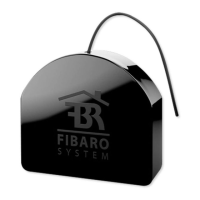
Do you have a question about the FIBARO ROLLER SHUTTER 3 and is the answer not in the manual?
| Device Type | Roller Shutter Controller |
|---|---|
| Protocol | Z-Wave |
| Radio Protocol | Z-Wave |
| Dimensions | 42.5 x 38.25 x 20.3 mm |
| Mounting Box Requirements | Ø ≥ 50mm, depth ≥ 60mm |
| Protection Class | IP20 |
| Maximum Load for AC Output | 4.2A |
| Max Transmit Power | up to 6 dBm |
| Range | Up to 50m (open space) |
| Operating Temperature | 0°C to 40°C |
| Z-Wave Frequency | 868.4 MHz EU |
| Compatibility | Works with various Z-Wave and Z-Wave Plus certified devices |
| Radio Frequency | 868.4 or 908.4 or 921.4 MHz EU frequency band |
Warning about the risks of electric shock during installation and operation.
Safety advice regarding simultaneous operation of multiple roller blinds.
Step-by-step guide for connecting the device for standard blinds.
Instructions for installing the device with blinds that have a built-in driver.
Procedure for installing the device for gate motors, including safety recommendations.
Calibration procedures for roller blinds using momentary switches.
Steps to calibrate the device using the B-button.
Using device parameters to perform positioning calibration.
Calibration using connected momentary switch for venetian blind slats.
Positioning calibration for roller blinds with built-in drivers.
How to operate roller blinds using momentary switches.
Managing the angle of venetian blind slats.
How to operate roller blinds using toggle switches.
Operating gate motors using a momentary switch.
Configuration for automatic gate closing after opening.
Methods to erase stored power and energy consumption data.
Steps to add device associations using the Home Center controller.
Z-Wave specification for Endpoint 1: Generic and Specific Device Classes.
Z-Wave specification for Endpoint 2: Generic and Specific Device Classes.
Z-Wave specification for Multichannel Command Class.
Z-Wave specification for Notification Command Class.
Z-Wave Protection Command Class details.
Z-Wave Meter Command Class details.
Defines the type of switch connected to S1 and S2 terminals.
Reverses operation of switches connected to S1 and S2.
Reverses operation of outputs Q1 and Q2.
Configures device reaction to alarm frames for the 1st slot.
Configures device reaction to alarm frames for the 2nd slot (Water).
Configures device reaction to alarm frames for the 3rd slot (Smoke).
Configures device reaction to alarm frames for the 4th slot (CO).
Configures device reaction to alarm frames for the 5th slot (Heat).
Determines actions that send scene IDs assigned to S1 switch.
Determines actions that send scene IDs assigned to S2 switch.
Configures whether to include device's own power consumption in metering.
Sets minimum power change for sending new power reports.
Sets interval for sending periodic power reports.
Sets minimum energy change for sending new energy reports.
Sets interval for sending periodic energy reports.
Enters the device into calibration mode.
Adjusts operation according to the connected device (blind, gate).
Determines time for full turn cycle of venetian blind slats.
Determines how slats return to previous position in various situations.
Time after which motor stops after end switch closure.
Power threshold to be interpreted as reaching a limit switch.
Time needed for roller blinds to reach the top.
Time needed for roller blinds to reach the bottom.
FCC compliance statement and operating conditions.
Industry Canada compliance statement.
Information regarding product changes, trademarks, and rights.
Warning statements regarding frequency, power, and interference.
Declaration of conformity with EU directives.
Information on proper disposal of the device.
